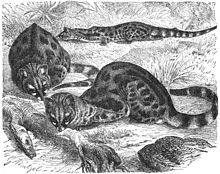Gorse cats
| Gorse cats | ||||||||||||
|---|---|---|---|---|---|---|---|---|---|---|---|---|

Southern Gorse Cat ( Genetta felina ) |
||||||||||||
| Systematics | ||||||||||||
|
||||||||||||
| Scientific name | ||||||||||||
| Genetta | ||||||||||||
| G. Cuvier , 1816 |
The genet cats ( Genetta ), also known as Genetten , are a predominantly African genus of the crawling cats (Viverridae) with 15 species. The Kleinfleck gorse cat is the only crawling cat that lives in Europe .
description
Gorse cats have an elongated body with rather short limbs. The face is characterized by the pointed snout and the large, round ears. Their fur is usually beige or gray in color with a striking black pattern. The tail is curled. As with many spotted predators, there is obviously a solid black morph ( melanism ) in every species . Genet cats reach a head body length of 42 to 58 centimeters, a tail length of 39 to 53 centimeters and a weight of 1 to 3 kilograms.
Distribution and habitat
Gorse cats are found in almost all of Africa, southwest Asia ( Arabian Peninsula ) and southwest Europe. Their habitat are both open habitats such as grasslands and dense forests.
Way of life

Gorse cats are nocturnal loners. During the day they sleep in crevices in the rock, in hollow tree trunks or in structures that they have taken over from other animals. They can climb very well, but mostly look for food on the ground.
They are territorial animals that inhabit a territory of up to eight square kilometers. The territories can overlap with those of animals of the opposite sex, but never with those of same-sex conspecifics. They can secrete a musky secretion with their anal glands , but various sounds are also used for communication.
food
Genets are omnivores that ingest small vertebrates, insects, and sometimes fruit. Sometimes they climb trees to catch bird eggs or young birds, but mostly they hunt on the ground, where they quietly approach their prey from a wait position.
Reproduction
The female gives birth to one to four (usually two or three) young animals up to twice a year after a gestation period of around 56 to 77 days. The female takes care of the animals, carries them around in her mouth and cleans them; it defends you against all intruders, even against your partner if he is still around. From the 2nd month of life, the young eat solid food. They are sexually mature at around 2 years of age. Life expectancy is not known exactly, animals in human care can live to be over 20 years.
species

The genus of genets is divided into four sub-genera with a total of 15 species:
- Subgenus Genetta
- The small-spotted genet ( Genetta genetta ) lives with several subspecies in Spain , Portugal , in Africa on both sides of the Sahara and in the south of the Arabian Peninsula ( Yemen and Oman ).
- The southern gorse cat ( Genetta felina ) from South Africa and Namibia has recently been listed as an independent species.
- The southern gorse cat ( Genetta tigrina ) is common in southern Africa ( South Africa and Lesotho ).
- The Pardelgenette ( Genetta pardina ) occurs from Senegal via Mali and Burkina Faso to Ghana .
- The rusty-spotted genet ( Genetta maculata ) is similar to the Southern rusty-spotted genet and is sometimes called with this conspecific viewed. It is common in large parts of sub-Saharan Africa.
- The king genette ( Genetta poensis ) from Liberia, Bioko, Ivory Coast, Ghana and the Democratic Republic of the Congo is known from only 10 specimens.
- The Giant Gorse ( Genetta victoriae ) lives in the east of the Democratic Republic of the Congo and in Uganda.
- The Serval genet ( Genetta servalina ) is common in central and eastern Africa (from Nigeria to Kenya ).
- The Angola genet ( Genetta angolensis ) is native to southern Africa in a strip from Angola to Mozambique .
- The crested gorse or Niger genette ( Genetta cristata ) lives in a small area in Nigeria and Cameroon . The species is considered threatened.
- The Bourlon-Genette ( Genetta bourloni ) lives in a small area in Guinea.
- Subgenus Pseudogenetta
- Subgenus Paragenetta
- The Liberia Genette ( Genetta johnstoni ) is native to West Africa (from Guinea to Ghana ).
- Subgenus Osbornictis
- The taxonomic position of the aquatic species ( Genetta piscivora ) within the genet is unclear. Some authors classify them in the monotypic genus Osbornictis .
See also
supporting documents
- ↑ Don E. Wilson & DeeAnn M. Reeder (eds.): Genetta ( Memento of the original from January 18, 2015 in the Internet Archive ) Info: The archive link was inserted automatically and has not yet been checked. Please check the original and archive link according to the instructions and then remove this notice. in Mammal Species of the World. A Taxonomic and Geographic Reference (3rd ed).
literature
- Ronald M. Nowak: Walker's Mammals of the World . 6th edition. Johns Hopkins University Press, Baltimore 1999, ISBN 0-8018-5789-9 (English).
- Don E. Wilson, Russell A. Mittermeier (Eds.): Handbook of the Mammals of the World. Volume 1: Carnivores. Lynx Edicions, 2009, ISBN 978-84-96553-49-1 .
- Don E. Wilson, DeAnn M. Reeder (Eds.): Species of the World: A Taxonomic and Geographic Reference (3rd edition) . Johns Hopkins University Press, 2005.



